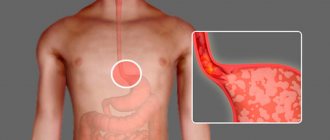- November 10, 2018
- Gastroenterology
- ArtMaks
The tongue can safely be considered a mirror of health. Even before the main symptoms of the disease appear, it begins to react to negative changes in the human body and gives certain signals. Does the tongue change with gastritis? Experts say that the development of any disease of the gastrointestinal tract affects its condition. Let's take a closer look at exactly what changes in the appearance of this organ should be alarming.
Functions
The tongue is one of the most important organs. The main purpose of this muscular organ is to determine taste using receptor papillae located on its surface. The tongue is also necessary for the mechanical processing of food and its uniform distribution throughout the oral cavity. Another important function of the organ is communication. It helps to communicate and transmit information.
Even in ancient times, doctors could determine the type of illness affecting the patient based on the condition of the tongue. The most striking symptoms are pathologies of the gastrointestinal tract. Moreover, they are most pronounced during the period of exacerbation of the disease and can completely disappear during its remission. Particular concern can be caused by a white coating on the tongue due to gastritis.
Differentiation of plaque in gastritis from other diseases of the gastrointestinal tract
A thick, grayish coating is characteristic of dysentery.
It is important to suspect the onset of a dangerous disease in time. To take action and prevent complications from occurring. Differential diagnosis by tongue of gastritis from other diseases and conditions:
- A thick, grayish coating is characteristic of dysentery. In this case, the tongue looks cracked, and less saliva is produced than usual.
- Desquamative glossitis - this type of inflammation of the tongue is characterized by such symptoms as red spots of complete absence of epithelium or several altered taste buds on the tongue, covered with a white coating.
- Galvanic stomatitis is a form of inflammation of the tongue that arises as a result of a reaction to metal prostheses, manifested by spots in the form of pimples, and subsequently by the appearance of erosions against a background of white plaque.
- Infectious diseases - sore throat, scarlet fever, diphtheria, HIV infection can cause the appearance of a white coating on the tongue, but almost all of these infections are accompanied by high fever and skin rashes.
- Diseases of the heart and blood vessels - plaque is located on the anterior third of the tongue.
- Kidney disease - plaque on the tongue is localized at the back along the edges.
- Endocrine disorders - under the plaques of white plaque there are ulcers and erosions.
- Anemia is not a coating on the tongue, but blanching of the entire surface of the organ. Diseases of the respiratory system are often indicated by the localization of white plaque on the front and along the edges of the tongue.
- Diseases of the salivary glands - the appearance of a white coating is accompanied by the appearance of an unpleasant odor.
- Diseases of the liver and gall bladder - the color of the plaque is not white, but has a yellowish or brown tint. A white coating on the tongue can be caused by the consumption of dairy products, as well as the proliferation of bacteria and fungi in those who abuse sweets. Unlike plaque during gastritis, such layers are easily removed and do not form further.
Read: What is xanthoma and why is it dangerous?
What kind of language should a healthy person have?
Normally, the muscular organ should be pale pink. A small amount of white plaque is allowed. In this case, the taste buds should be clearly visible. There is a hollow running down the center of the tongue. Excessive salivation or surface dryness indicates the development of a pathological condition. A healthy person's tongue is slightly moist.
Plaque on the tongue in the morning is considered normal if it can be easily removed by brushing your teeth. If such a symptom causes discomfort and unpleasant sensations, you should consult a doctor. The severity of the pathology is indicated by the thickness of this plaque. With serious illnesses, the deposits will be thicker.
What does a healthy tongue look like?
To check your health, carefully examine your tongue in the morning, immediately after waking up. If you are healthy, then this organ should look like this:
- the surface is covered with smooth, noticeable, but not protruding taste buds;
- pink color, not too saturated;
- plaque may be present in small quantities, and it should be translucent, slightly darker than the base tone of the tongue;
- humidity is moderate, dryness is a sign of pathology, but too much salivation is not the norm;
- no unpleasant odor.
Advice! Normal oral health can be considered a sign of good health, provided there are no other symptoms - pain, poor health, etc.
But an unusual condition of the tongue is a reason to consult a doctor, since this can be a sign of both functional disorders and serious diseases. If the appearance changes and plaque appears, accompanied by pain in the upper abdomen, nausea and heartburn, gastritis can be suspected.
Therefore, the patient needs to contact a gastroenterologist. Of course, the specialist will not limit himself to an external examination; he will definitely prescribe studies that will make it possible to make an accurate diagnosis.
What language should you use for gastritis?
The most common disease affecting the digestive system is gastritis - inflammation of the gastric mucosa. This condition disrupts the normal process of food digestion and causes pain. The oral cavity, which is part of the digestive system, is capable of displaying any malfunction in the functioning of internal organs. This can be recognized by the condition of the mucous membranes of the mouth and tongue.
What pathology does a white tongue indicate? With gastritis and other gastrointestinal diseases, a similar symptom appears. Moreover, the main accumulation of plaque in these cases is concentrated at the root of the tongue. It is also worth paying attention to the surface relief of the muscle organ. With gastritis with low acidity, it will be smooth and slightly dry. The pathology caused by an increased level of hydrochloric acid in the stomach is characterized by a rough tongue.
Plaque on the tongue during gastritis: photo, diagnosis, and treatment of white and dense formation
Language is an indicator of human health.
In case of diseases of the internal organs, a trace in the form of plaque remains on it. the tongue becomes coated and changes its surface structure.
That is why specialists pay special attention to it during the initial diagnosis of stomach disease.
What does a healthy tongue look like?
Keep in mind! An absolutely healthy tongue should look like this:
- pale pink color , a translucent coating is allowed or a little brighter than the main shade after waking up. Other tones indicate the development of certain diseases;
- uniform taste buds of small size;
- moderately wet - too dry tongue or increased salivation indicate pathology;
- absence of foreign unpleasant odors.
If gastritis is suspected, special attention should be paid to the central area of the tongue.
It is she who becomes covered with plaque in this disease.
Features of deposits in gastritis
Note! One of the characteristic symptoms of gastritis is an atypical coating on this sensory organ.
Its appearance depends on the form, stage and type of the disease. The level of secretion especially affects how deposits look.
Photo
The photo shows examples of raids:
Gastritis with low acidity
- Low acidity of gastric juice significantly impairs the digestion process.
- Even after eating a small portion of food, there is a feeling of heaviness in the stomach.
- Often there is a belch with the smell of an eaten or rotten egg.
You should know! The main signs of a disease with low acidity:
- unpleasant taste in the mouth;
- frequent stomach upset;
- nausea;
- hair loss;
- weight loss;
- waviness of the nail plates.
The appearance of the tongue also changes . Patients with this pathology notice the following signs:
- excessive dryness;
- swelling;
- the lingual surface becomes glossy, the papillae are practically not visible.
In addition, there is a burning sensation in the mouth.
As for the plaque , it becomes grayish , quite dense in structure, with an extremely unpleasant odor .
Hyperacid gastritis
For your information! In the form of the disease with high acidity, the appearance of the tongue surface also changes.
The bottom line is that excessive production of hydrochloric acid is activated in the stomach, which causes irritation of the stomach walls, erosions and ulcers can form.
Hyperacid gastritis is characterized by the following symptoms on the surface of this sensory organ :
- the papillae become larger, the surface becomes rougher;
- belching sour, resulting in a burning sensation in the mouth;
- in general, normal humidity, but sometimes increased salivation appears.
With gastritis with high acidity, a burning sensation is felt on the tongue . This occurs due to the fact that acid is thrown into the esophagus.
At first, this process is accompanied by heartburn, after which bitterness appears in the mouth, then the person notices that there is a strong burning sensation in the mouth.
Stay up to date! A burning sensation in the mouth occurs not only with gastritis, but also with dental diseases.
Acute and chronic forms
- Acute gastritis is accompanied by severe symptoms - severe abdominal pain, nausea, elevated body temperature.
- A white-gray coating of dense texture appears on the tongue surface , covering the entire surface except the tip.
- In the chronic form , a not very dense white coating forms on the surface .
- During exacerbation, it becomes covered with white-gray spots.
It is always located in the central part of the tongue. After it is eliminated, it forms again after some time.
Important! If, in the chronic form of gastritis, bright red spots periodically appear on the tongue, this indicates that a stomach ulcer has begun to develop.
Diagnostics
The appearance of the tongue can tell about a person's health status. The plaque on it suggests what form of gastritis is developing.
But this is only during the initial examination. To establish an accurate diagnosis, a number of studies are required.
Based on their results, the doctor can accurately say why plaque appeared on the surface of the tongue, whether it is a consequence of gastritis or another pathology.
White plaque indicates a chronic form of the disease, white-gray plaque indicates acute or exacerbation of gastritis.
How to get rid of plaque?
A white or white-gray coating on the tongue with an unpleasant odor from the oral cavity causes discomfort in a person.
It is worth noting! This condition is a favorable environment for the development of pathogenic microorganisms.
That is why it is necessary to carefully observe the rules of personal hygiene . It includes the following rules:
- You should clean your tongue and cheeks using auxiliary attachments or part of a toothbrush.
- It is necessary to clean carefully so as not to damage the papillae. This is done in the direction from the base to the tip of the tongue.
- If the coating on the surface is very dense, you need to use a softener . This could be a soda solution or other specialized products that are sold in pharmacies.
- brush your teeth 2 times a day . This will help get rid of bad breath. To neutralize it, you can also use special air fresheners.
- After brushing your teeth, you must rinse your mouth well.
- eliminate the bitter taste in your mouth by using mineral water, sage or chamomile decoction for rinsing.
- You should use mouthwash after every meal.
Reference! Alternative medicine will help to cope with the unpleasant feeling of bitterness in the mouth for the treatment of gastritis:
- Drink 1 glass of flax seed infusion every day It will eliminate not only bitterness, but also other unpleasant symptoms.
- A good way is corn silk infusion .
To prepare it, take 1 tablespoon of crushed dried stigmas, pour 1 glass of boiling water, leave for 2-3 hours. Drink the finished product in small portions throughout the day.
Does the form of the disease affect it?
With gastritis, the tongue is almost always coated. Based on its nature, the doctor can determine the form of stomach pathology. If the plaque has a viscous consistency and a gray tint, it means that an acute form of pathology is developing. In this case, a large area of the organ is covered with plaque. Only the sides and the tip of the tongue can remain clean. In addition, severe dryness appears in the mouth or, conversely, increased secretion of the salivary glands is observed. A constant sour taste, regardless of food intake, is another symptom of acute gastritis.
The hyperacid type of gastritis is characterized by swelling of the tongue. A patient suffering from this phenomenon feels discomfort and lack of space in the oral cavity. Teeth imprints appear on the lateral surfaces of the organ, the tissue structure becomes loose, and hypertrophied papillae increase.
Special symptoms
“Geographic tongue” is a syndrome in which gray or pink spots appear on the surface of the organ. The phenomenon is associated with dystrophic and inflammatory processes on the mucous membrane of the organ. Often occurs when the functionality of the gastrointestinal tract is impaired.
The main signs of the acute course of the disease also include:
- severe pain in the epigastric region, occurring mainly after eating;
- feeling of heaviness in the stomach;
- sour belching;
- heartburn;
- general weakness;
- diarrhea.
It is important to start therapy in a timely manner. This will help not only alleviate the condition, but also prevent the disease from becoming chronic.
How to clean your tongue correctly
Personal hygiene is the basis of health. To effectively get rid of plaque, you need to eliminate the root cause of its appearance. Having discovered plaque, you should consult a doctor who will diagnose and prescribe effective treatment.
To forget about bad breath, you need to brush your teeth twice every day, while cleaning your tongue and cheeks, following the following rules:
- The oral cavity should be cleaned carefully and carefully, without injuring the taste buds.
- Start cleaning from the base and finish at the edge.
- To soften plaque, you can rinse with a non-concentrated solution of potassium permanganate or soda.
There are now many mouthwashes available that contain medicinal plants. After cleansing, rinse your mouth with clean water. In addition, at pharmacy kiosks you can purchase special lollipops, chewing gum or aerosols that will help you easily get rid of plaque and bad breath.
Do not forget that the tongue is considered an indicator of the condition of the internal organs, and the presence of a disease can be determined by its appearance. Timely examination and attentiveness to the manifestations of signs will help to avoid the development of pathologies of the gastrointestinal system and other diseases.
Chronic gastritis
What is the tongue like with chronic gastritis? A white coating of dense consistency is the main sign of protracted inflammation of the gastric mucosa. Clearing the tongue of such plaque becomes problematic. In most cases, this symptom indicates the presence of serious disorders in the functioning of the digestive tract. During an exacerbation, the patient is most often bothered by symptoms such as flatulence, abdominal pain, upset stool, and belching.
In the chronic course of the pathology, insufficiency of secretory function is usually observed. Due to a lack of gastric juice and changes in acidity, a characteristic whitish coating often appears on the tongue. Moreover, in some cases it does not completely cover the surface of the organ, but only in spots.
The tongue with gastritis with high acidity may have a white coating with orange impurities. This is observed when gastric juice refluxes into the oral cavity during belching. The plaque covers the tongue with a thick layer and has an unpleasant odor.
Other pathologies
Plaque appears on the tongue not only in diseases of the digestive system. For example, a similar symptom is often observed in young children and is associated with dysbiosis. Negative changes in the intestinal microflora have a detrimental effect on the condition of the entire digestive system. The appearance of white plaque, stool disturbances, loss of appetite, and bad breath indicates the need to restore the required amount of beneficial bacteria.
Diabetes mellitus can also cause plaque on the speech organ. In this case, its formation is associated with a violation of water balance. The saliva produced contains large amounts of glucose, which causes thirst. In this case, it is possible to get rid of plaque only by treating the underlying disease.
The appearance of plaque on the tongue of infants is a sign of candidiasis. Fungal pathology requires special treatment under the supervision of a specialist.
Appearance of the tongue depending on the type of disease
Depending on how the tongue looks, you can judge the type of disease. Gastritis happens:
- Spicy. A gray viscous coating appears on the tongue, which covers the main part of it, without affecting the side zones. A sour taste may appear in your mouth. Salivation increases. However, this type of disease can also cause xerostomia - a decrease in saliva production, which causes dry mouth and even cracks on the tongue and throughout the oral cavity. Insufficient salivation disrupts the functioning of taste buds. This is often observed with problems with the endocrine and central nervous system. If a patient has been treating gastritis for a long time, dry mouth may occur due to prolonged use of medications.
- Chronic. It is divided into antral and atrophic. The first occurs due to increased activity of the bacterium Helicobacter pylori, and the second is an advanced form of the disease and is considered a precancerous stage. A thick white coating appears on the tongue, the papillae become enlarged, and sometimes ulcers may even appear. During exacerbation, the plaque turns yellow.
- Ulcerative. The mucous membrane turns blue, a burning sensation appears, and a lot of saliva is released. The coating is gray with red splashes and cannot be cleaned. A burning tongue occurs due to the fact that it is exposed to hydrochloric acid or bacteria. Glossitis may occur - inflammation, which in advanced cases leads to warty and papillary growths on the tongue.
Bitterness in the mouth due to gastritis can occur with any type of gastritis. It occurs when the patient eats foods that he should not eat, drinks alcohol and smokes.
The patient's stomach is not able to cope with fatty, spicy and salty foods; they are not completely digested.
Undigested remains begin to move through the digestive system, releasing gases that rise up the esophagus. They become the cause of bitterness.
Important information: Is it possible to take fish oil for gastritis?
Another pronounced problem is bad breath due to gastritis. The reasons for its appearance are a coating on the tongue, the presence of food debris in the stomach, and inflammation of the tonsils. This specific odor from the mouth is called halitosis. It can be constant, or it can appear if you don’t follow a diet. The smell can be sour or rotten, and it is often difficult to cope with, even if you carry out the necessary oral hygiene.
Diagnosis of gastritis
A gastroenterologist is the main specialist who deals with problems of the gastrointestinal tract. If you experience pain in the epigastrium, plaque on the tongue, or stool disorders, you should seek help from this doctor.
Naturally, the doctor will not be able to make an accurate diagnosis based solely on the condition of the tongue. But a visual examination of the condition of the oral cavity will tell you a lot. The color of the tongue with gastritis may be within normal limits if the disease is in remission. During exacerbation, redness of the lateral parts or the entire surface is observed.
The form of the course and type of gastritis should be determined using instrumental diagnostic methods. One of the most accurate methods is FGDS. During the examination, a thin hose is inserted into the patient through the oral cavity, at the end of which a camera is attached. This allows the doctor to see the condition of the inner surface of the stomach.
To determine the level of acidity of gastric juice, PH-metry is prescribed, which is most often performed during fibrogastroduodenoscopy. The patient will also need to undergo blood, stool and urine tests.
Diagnostics
So, the appearance of the tongue can indicate the presence of various diseases. By assessing the type of plaque, we can assume what particular form of gastritis is developing in the patient. Of course, diagnosis by appearance is just an auxiliary technique; in order to make an accurate diagnosis, you need to conduct a series of examinations.
Only based on the results of the examination, a specialist will be able to tell why the white plaque appeared and whether it is a sign of gastritis or another disease. A white coating on the tongue is characteristic of the chronic form of the disease, but a white-gray coating more often indicates an exacerbation or progression of the acute form.
The appearance of white plaque in the chronic form can be noted not only in the morning, but also throughout the day, even after cleansing. Yellow plaque in patients with gastritis can be observed in the infectious form of the disease, as well as if the stomach disease is accompanied by a violation of the secretion of bile.
In the latter case, in addition to a change in the color of the plaque, patients note the appearance of a bitter taste in the mouth. Red spots on the tongue may be a sign of the onset of an ulcer, so do not ignore this symptom.
Treatment
Acute gastritis, indicated by a thick white-gray coating on the tongue, requires immediate treatment. First of all, you need to relieve painful symptoms, rinse the stomach (in case of poisoning), and eliminate irritating factors. Mechanical cleansing of the tongue from plaque will be ineffective. After some time it appears on the organ again.
Self-medication for acute gastritis is extremely dangerous. Medicines should only be prescribed by a doctor.
“No-shpa”, “Papaverine”, “Platifillin” will help relieve pain syndrome. The dosage of medications is selected individually. If the disease has a bacterial etiology, that is, caused by infection with Helicobacter pylori, mandatory use of antibiotics will be required. Drugs such as De-Nol, Clarithromycin, and Amoxicillin can cope with pathogenic microbes. The duration of such therapy is 10 days.
Gray spots on the tongue with gastritis indicate the possible appearance of an ulcer. In this case, drugs that increase the protective properties of the gastric mucosa are necessarily prescribed: Ventroxol, Enprostil, Biogastron, Venter.
Proton pump inhibitors are an essential component of the treatment of gastrointestinal pathologies. Drugs in this category are capable of inhibiting the processes of hydrochloric acid secretion. The most effective of them are “Omez”, “Omeprazole”, “Ultop”, “Bioprazole”.
Is the raid dangerous?
The coating on the tongue itself is not dangerous to the body. When gastritis is cured, the condition of the tongue returns to normal.
Treatment of gastritis is a long and complex process, during which all the doctor’s instructions should be strictly followed.
To clarify the diagnosis, the doctor may prescribe additional diagnostics using the following methods:
- Fibrogastroduodenoscopy.
- Ultrasonography.
- Laboratory tests of gastric secretions and blood.
For treatment, the doctor usually prescribes the following medications:
- complex use of antibiotics;
- pre- and probiotics;
- antacid drugs;
- vitamin complexes;
- proton pump blockers.
Patients with gastritis must adhere to a strict diet, the purpose of which is to spare the mucous membrane of the digestive organ and not contribute to the release of excess hydrochloric acid.
Complex therapy will return the gastric lining to a healthy state.
Recommendations
To prevent the appearance of spots and plaque on the tongue caused by disruption of the gastrointestinal tract, you should give up bad habits and adhere to proper nutrition. After all, gastritis and other pathologies of the digestive system most often develop against the background of regular consumption of fatty, smoked, spicy foods, fast food, coffee, and alcoholic beverages.
If you have gastritis, you can clean your tongue from plaque using a toothbrush, which has a special grooved surface. You can also buy scrapers for cleaning the surface of the tongue in pharmacies. Rinsing with decoctions of medicinal herbs (chamomile, sage) and oak bark will also bring benefits. They have antiseptic properties and will protect the oral cavity from infection.











